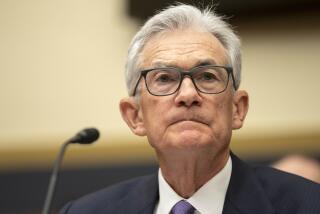Bank of England not ready to raise rates despite unemployment drop

The Bank of England sees “no immediate need” to raise rock-bottom interest rates despite an unemployment rate that is falling more rapidly than anticipated, according to minutes of its January meeting released Wednesday.
Just like Federal Reserve officials in Washington, Bank of England policymakers are grappling with how to remove monetary policy stimulus without harming an economic recovery.
Similar to the situation in the U.S., the unemployment rate in Britain has been falling faster than anticipated. The drop complicates monetary policy, in part because it’s unclear if the falling unemployment rate accurately reflects the state of the labor market.
PHOTOS: Federal Reserve chairs through the years
Bank of England policymakers have tied an increase in its 0.5% interest rate to the unemployment rate dropping to 7%.
They had not expected such a drop until February 2015.
But the latest data, for the three months ended Nov. 30, show the unemployment rate dropped to 7.1%. The rate had been 7.4% for the three months ended Oct. 31.
The minutes show policymakers believed that “the unemployment rate was now likely to reach the 7% threshold materially earlier than previously had been expected.”
Still, the members of the Bank of England Monetary Policy Committee “saw no immediate need” to raise its benchmark interest rate “even if the 7% unemployment threshold were to be reached in the near future.”
The committee voted unanimously at the Jan. 8-9 meeting to hold the rate steady.
The Fed is dealing with similar issues. The central bank had anticipated ending its latest bond-buying stimulus program when the U.S. unemployment rate reached 7%.
But the rate fell to 7% in November, before the Fed even had begun to start the slow reduction in its $85 billion in monthly bond purchases.
Fed policymakers voted last month to start reducing the purchases by $10 billion a month. The Labor Department reported on Jan. 10 that the unemployment rate fell to 6.7% in December, although the drop was attributed to discouraged Americans dropping out of the workforce.
Fed officials said in December they would hold their benchmark short-term interest rate near zero until “well past the time” that the unemployment rate drops below 6.5%.
The language was a change from an earlier promise to hold the rate low as long as the unemployment rate was above 6.5%.
ALSO:
Covered California faulted for low Latino enrollment
Only one of 11 subcompact cars passes insurance group’s new crash test







